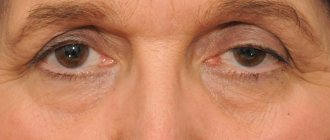Canthoplasty (canthopexy) - correction of eye shape
Plastic surgery does not stand still, so every day people all over the world have a chance to become more perfect.
Recently, the procedure of canthopexy and canthoplasty has become very popular. Canthopexy and canthoplasty allow you to change the shape of the eyes, tighten the corner of the eyelids, thereby achieving an aesthetic appearance of the entire face. The procedure received its name due to the fact that any operation performed in one way or another affects the canthal tendon in the eyelid area, which is responsible for support.
This procedure is most popular among people who have severe ptosis (sagging eyelids) and too narrow/wide eye shape. Canthoplasty is also suitable for those who have drooping eyelids due to age-related changes. Canthopexy helps to “rejuvenate” the look, since the procedure tightens the lower eyelid and also removes ectropion (a case where the eyelid is slightly inverted).
Contraindications
Contraindications to canthoplasty are:
- diabetes mellitus of any type;
- chronic pathologies of the eyelids and conjunctivitis in the acute stage;
- blood clotting disorder;
- pronounced myopia;
- sudden jumps in eye pressure;
- thyrotoxicosis;
- dry eyes;
- infectious diseases in the acute stage, as well as the presence of chronic infection in the body;
- exacerbation of any chronic pathologies.
What is the difference between classic blepharoplasty and canthoplasty?
In fact, patients often hear about the blepharoplasty procedure, but it is worth understanding that the difference between these operations is quite significant.
Blepharoplasty is effective in cases of slight sagging eyelids, bags under the eyes, crow's feet and shallow wrinkles. Canthoplasty is a more serious procedure. It implies a different method of performing the operation.
Due to age-related loss of support, our eyelids gradually begin to droop. It is in such cases that canthopexy (canthoplasty) can restore the necessary support to the eyelid, get rid of a “tired” face, and even restore facial asymmetry in case of facial nerve paralysis. Canthopexy (canthoplasty) also helps with thyrotoxicosis (thyroid disease), when patients experience unpleasant consequences in the form of exophthalmos (protrusion of the eyeballs).
In the case of the same ectropion (inverted eyelid), blepharoplasty is useless. Moreover, this procedure can even worsen the problem.
However, at the moment it is possible to carry out both procedures simultaneously, which will make the result longer and more effective.
Pros and cons of the procedure
In most cases, patients who have had canthoplasty are satisfied with the result and speak positively about the procedure; they emphasize that canthoplasty has allowed:
- make the skin around the eyes more elastic and firm;
- remove asymmetry;
- eliminate bags;
- smooth out wrinkles in the eye area;
- give the look openness and youth;
- raise the outer corners;
- reduce intraocular pressure;
- adjust size and shape.
But, like any other surgical intervention, canthoplasty also has its disadvantages, for example:
- quite high cost;
- the presence of a number of contraindications;
- the likelihood of complications;
- forced lifestyle changes before and after surgery;
- difficulties in choosing a good clinic and qualified specialist.
How is canthopexy performed?
The method of performing the operation is very individual.
During a face-to-face examination, the doctor discusses the desired result with the patient, conducts an examination and assesses the amount of work. During the operation, an incision of no more than one centimeter horizontally is most often made above the upper eyelid. This incision helps hide the postoperative cosmetic stitch in the natural crease of the eyelid.
By means of this suture, the surgeon has access to the canthal tendon, which the surgeon subsequently attracts to the ocular periosteum. Again, in some cases, excess skin may need to be excised.
The cost of canthoplasty (canthopexy) is determined after an in-person or correspondence consultation. Approximately $500 for upper OR lower eyelids.
After canthoplasty (canthopexy)
After the operation, there is slight swelling of the eyes, and possible accumulation of blood in the form of hematomas. However, the recovery period is very short: usually within a week, patients can return to their previous work. The pain is minimal and can be relieved with painkillers.
The postoperative suture may subsequently disappear almost completely. In any case, it is absolutely invisible in the natural crease of the eyelid.
The result can be observed immediately after the swelling subsides. The effect of canthoplasty can last more than 10 years.
Our clinics are equipped with the latest equipment, which plastic surgeons have mastered to perfection. That is why the recovery period is minimal, and surgical traces are completely invisible. Another undeniable plus is the complete confidentiality of each patient.
It is necessary to understand that in the case of various plastic manipulations, the qualifications of the doctor are very important . Strict quality control is carried out in Belarus, especially with patients from abroad. Take advantage of the services of our company, because we cooperate with the best doctors and clinics in Belarus
Canthopexy: BEFORE and AFTER photos
See all photos
How does a patient recover after canthoplasty and canthopexy?
The rehabilitation period lasts from 14 to 30 days, with the first three days considered the most critical. During these days, the patient may experience pain, dry eyes, severe swelling, hematomas and bruises. The mucous membrane is irritated, and blurred vision may occur.
The surgeon removes the stitches for 6-9 days, and swelling and hematomas go away after 14-20 days. During the recovery period, you must follow the doctor's recommendations: do not engage in active sports, do not bend over, avoid lifting heavy objects. Eye cosmetics can be used after two to three weeks to avoid infection.
What effect can be obtained after lifting the corners of the eyes?
The look becomes more open, clearer, the effect of a dull and depressive facial expression disappears, congenital or acquired asymmetry is eliminated, and excellent visual rejuvenation of the face is achieved!
Specialists at the Butko Plastic clinic perform canthopexy in Moscow. Hurry up to make an appointment to appreciate all the benefits of performing plastic surgery by a surgeon with more than 20 years of experience - Igor Butko. As of 2022, the specialist has performed more than five thousand successful operations, including canthopexy. The clinic successfully develops and implements proprietary techniques that significantly improve the quality and safety of the operation. If you want to fall into the hands of professionals in your field and get the result you dreamed of, sign up for a consultation at Butko Plastic.
The price of canthopexy is around 35,000 rubles.
In what cases can epicanthoplasty be performed?
Epicanthoplasty is a cosmetic manipulation; every patient who has no contraindications is allowed to use it. Most patients are of Asian descent, but the surgery is performed for cosmetic defects in one eye.
It is an ideal procedure for male or female patients with the following indications:
- severe drooping of the eyelids caused by skin folds;
- large amount of fat in the upper eyelid area;
- tissue ptosis;
- narrow shape
- congenital anomaly.
Indications for implementation are external reasons. It is performed if the Mongolian fold occurs due to the formation of scars after injury.
What can replace canthoplasty?
- Correct application of makeup . This method is the safest, harmless and accessible in order to give expressiveness to the look.
- Blepharoplasty of eyelids. Represents the elimination of fatty formations and excess skin on the eyelids.
- Thread lifting . During this method, special threads are inserted into the dermis through thin punctures;
- Hardware plasma lifting. It involves tightening problem skin using a pad cuff or plasma liner.
It is worth noting that representatives of the Asian age prefer to do Singapore, this is a correction of the upper eyelid, which allows you to form a decorative fold, due to which the appearance acquires European features.
Reviews
I have always taken great care of myself, but whatever one may say, age is taking its toll, and my eyes began to look tired and sad. The reflection in the mirror was not at all pleasing, and I decided to have canthoplasty. This is a low-traumatic operation that allowed me to look young and beautiful again. The operation lasts only an hour, is performed under local anesthesia, and the rehabilitation period is short. I'm very pleased with the result
Valentina
Izhevsk
After 30 years, the outer corners of the eyes began to droop and the face began to look tired and dissatisfied. No creams or masks helped, and there was only one way out - surgery. Having learned about canthoplasty, I decided to opt for it - a simple and low-traumatic operation. The effect after it is amazing
Maria
Saint Petersburg
I advise everyone who is planning canthoplasty to be very careful when choosing a clinic and a doctor. My operation was unsuccessful - my eyelid muscles were too tight, and now my eyelids do not close tightly. I'm waiting for when it will be possible to do a second intervention.
Ilona
Kirov
Canthoplasty is a very effective operation. In my case, she allowed me to change the shape of my eyelids, making my eyes more beautiful, almond-shaped. There were no complications, rehabilitation was easy, I recommend it to anyone who wants to change the shape of their eyes - quickly, uncomplicated and with good results
Svetlana
Sochi
Effective oils
The sooner you start fighting wrinkles in the corners of your eyes, the more chances you have for effective facial rejuvenation. Vegetable oil, designed to improve the elasticity and quality of the skin, will help remove the first wrinkles and eliminate other skin defects associated with the aging process. Modern cosmetology suggests using the following types of oily solutions:
- jojoba oil;
- olive oil;
- grape seed oil;
- Castor oil;
- cacao butter;
- linseed oil;
- Coconut oil;
- Peach oil;
- sea buckthorn oil;
- almond oil;
- argan oil;
- wheat germ oil;
- rosehip oil.
Progress of the operation
Before the operation, a consultation with a doctor is necessary, who determines the patient’s condition, assesses the degree of changes in the skin and tendon stretching, and also prescribes a small examination to identify contraindications - urine and blood tests, ECG, fluorography.
If no contraindications are identified, computer modeling of the expected result is performed. When the date of the operation is set, the patient should not sunbathe, visit the solarium, or engage in extreme sports 2-3 weeks before the operation. A week before surgery, you need to completely stop taking medications that thin the blood, and also reduce the consumption of coffee, alcohol, and try not to smoke.
The operation lasts about an hour and does not require deep anesthesia; local anesthesia is sufficient.
Progress of the operation:
- a centimeter incision is made under the eyelash line;
- the fold of the upper eyelid is dissected closer to the inner or outer corner of the eye (depending on the technique);
- the eye muscles and tendons are tightened;
- if necessary, excess skin and fat are removed;
- the incisions are sutured;
- The stitches are removed after about a week.
Kinds
Depending on the problem facing the surgeon, he chooses one of two canthoplasty techniques - medial or lateral. If necessary, they can be combined.
The medial technique involves manipulation of the inner corner of the eye, where the tendons are located. When they are tightened, the shape of the eye changes slightly. This method is mainly used during aesthetic surgery.
The lateral technique is used during manipulations at the outer corners of the eye. When they drop, the eye looks tired and the face itself is dissatisfied. Such changes can be noticed after 30–35 years. This operation also allows you to remove wrinkles, crow's feet, and correct skin folds.
The advantage of these techniques is that tendon tightening is carried out without significant damage to the skin, which greatly reduces the recovery period. But if you need to remove significant sagging skin, as well as remove fatty hernias under the eyes, these methods will not work. They must be combined with other types of blepharoplasty.
Rehabilitation after
Immediately after the anesthesia wears off, the patient can open his eyes, however, vision may be blurred at first.
The most important from the point of view of the development of possible complications are the first 3 days after surgery, so during these days you need to especially carefully monitor the condition of the operated area so as not to miss the onset of the development of pathological processes.
Swelling and soreness of the eyelids persists for about a week, during which time the doctor prescribes painkillers and eye drops.
After the operation, the eyes need a gentle regime for several weeks - you cannot read, work at the computer, visit swimming pools and solariums, use contact lenses and cosmetics, you must avoid sunlight and increased physical activity. It is recommended to sleep on a high pillow and only on your back.
After 10 days, to speed up the healing process, you can begin physical therapy - ultrasound or darsonval.
The recovery period takes 2 months.
Possible complications
The following complications are possible after canthoplasty:
- seal in the seam area;
- swelling and hematomas;
- dry eyes, irritation, discomfort.
Serious complications are:
- non-closure of the eyelids - too much skin excision;
- eversion of the eyelid - too much tension in the tendons or muscles;
- suppuration of sutures;
- bleeding - the stitches are not placed tightly enough;
- significant dryness of the eye - damage or blockage of the tear duct.
What then is canthopexy?
Canthopexy uses sutures to tighten and stabilize the same tendons and muscles without separating them from the bone, and often involves removing excess sagging skin. As a result of the correction, the lower eyelid stops sagging.
Let's give a small example, canthopexy - photos before and after the procedure:
In the photo: before the procedure
In the photo: after the procedure
So what will we choose?
Indications for surgery
In addition to the desire to become more attractive, there are a number of medical indications:
The effect of “bulging” eyes due to myopia
Chronic inflammatory processes and associated consequences
Drooping of the outer corner of the eye due to weakening of tendons and muscles
Eversion of the lower eyelid (ectropion)
Congenital pathologies of the eyelid (incomplete clefting, partial fusion - ankyloblepharon)
Narrowing of the eye opening - blepharophimosis
Chronic diseases of the conjunctiva
Preoperative preparation
Consultation with an ophthalmologist at the preparatory stage is very important, since we are talking about intervention in the orbital tissue of the eye. After the eye doctor gives permission for surgery, you should undergo a series of examinations, which will be prescribed by a plastic surgeon. Among them:
General analysis of urine and blood
Test for HIV, RV, hepatitis B
Determination of blood group and Rh factor
Allergy tests for anesthesia drugs
Other studies (as indicated)
Examination in the preparatory period is necessary, first of all, to identify contraindications to the procedure. But every patient should know about diseases for which canthoplasty cannot be performed:
Blood diseases (clotting disorders)
Increased intraocular pressure
Dry eye syndrome
Pregnancy and lactation
Canthoplasty: before and after photos
In order to compare the results of the operation, the plastic surgeon must take photographs of the face from different angles, and especially the eye area. There is also a special computer program that allows you to visualize what awaits the patient after canthoplasty is done. Before and after are 2 images that will allow the client to admire their appearance before the procedure.











